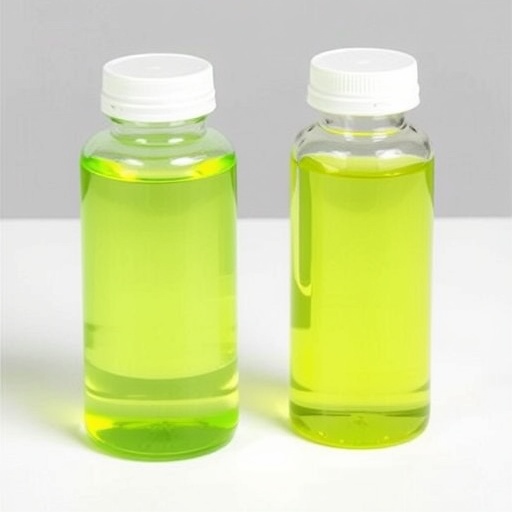
In the relentless pursuit of understanding the complexities embedded within plastic materials, a groundbreaking study has emerged, shedding unprecedented light on the additives that permeate everyday plastics. Williams and Aravamudhan’s recent publication in Microplastics & Nanoplastics ventures boldly into the intricate world of plastic additives through a novel semi-quantitative computational analysis, capitalizing on curated databases known as FLOPP-E and SLOPP-E. Their work lays the foundation for decoding the chemical fabric that shapes plastic properties, environmental fate, and potential human health impacts in ways previously unattainable.
Plastic additives—those often overlooked but essential compounds—serve as functional pillars that enable plastics’ desired mechanical strength, flexibility, flame retardancy, UV resistance, and longevity. Despite their critical roles, the vast complexity and diversity of these additives have obfuscated holistic analyses, creating significant knowledge gaps about their environmental distribution, degradation pathways, and toxicity. The researchers’ semi-quantitative computational approach leverages advanced data mining and algorithmic techniques to dissect subsets of two comprehensive databases, enabling them to extract meaningful insights about additive types and concentrations with remarkable computational efficiency.
The FLOPP-E (Flame retardant, Lubricant, and Other Plastic Additives – Environmental) and SLOPP-E (Stabilizers, Light-absorbers, and Other Plastic Additives – Environmental) databases serve as invaluable reservoirs of chemical information. These repositories compile thousands of records concerning plastic additives’ physicochemical properties, environmental behavior, and potential bioaccumulation tendencies. The study’s focus on discrete subsets from these extensive datasets highlights the researchers’ methodological precision, targeting specific additive classes heavily implicated in environmental persistence and toxicity.
.adsslot_hi6tPH8edx{width:728px !important;height:90px !important;}
@media(max-width:1199px){ .adsslot_hi6tPH8edx{width:468px !important;height:60px !important;}
}
@media(max-width:767px){ .adsslot_hi6tPH8edx{width:320px !important;height:50px !important;}
}
ADVERTISEMENT
At the heart of the study lies a sophisticated semi-quantitative framework that bridges the gap between traditional qualitative chemical cataloging and fully quantitative analytical methods, which can be prohibitively expensive and time-consuming. By leveraging computational chemistry, chemoinformatics, and machine learning-based pattern recognition, the team established a protocol for indexing additive profiles in plastics based on publicly available and proprietary data. This hybridized method offers nuanced resolution, enabling estimation of relative additive burdens within plastics without the exhaustive requirement of full chemical assay.
Williams and Aravamudhan convincingly demonstrate that semi-quantitative computational analysis can detect specific additive “signatures” that correlate with particular plastic types and manufacturing histories. This capability is transformative from a regulatory and environmental monitoring perspective: it equips stakeholders with the ability to fingerprint plastic debris found in the environment, thereby tracing back to potential industrial sources or usage patterns. Such forensic-level insights drastically enhance the efficacy of pollution mitigation strategies and consumer safety regulations.
Intriguingly, the study reveals certain additive classes, such as brominated flame retardants and phthalate plasticizers, maintain disproportionately high presence in some plastic subtypes, corroborating long-standing toxicological concerns about their environmental and biological impacts. The computational models predict that these additives not only persist during plastic degradation but also have high potential for bioaccumulation in aquatic organisms, amplifying ecological risks. This aligns with emerging evidence linking microplastic ingestion to perturbations in aquatic food webs.
Moreover, the semi-quantitative approach provides temporal forecasting capabilities by assessing additive degradation rates inferred from physicochemical parameters embedded in FLOPP-E and SLOPP-E data. The dynamic simulation of additive persistence offers valuable predictive insights into long-term environmental loading scenarios under various climatic and anthropogenic stressors. This predictive power is critical for policymakers aiming to preemptively regulate additives that may exacerbate microplastic pollution in the future.
The computational pipeline also addresses analytical bottlenecks that have historically plagued the field. Conventional additive identification often requires labor-intensive extraction and chromatography-mass spectrometry analyses, which are limited by sampling bias and detection thresholds. By contrast, the in silico methodology here circumvents such constraints, broadening the scale and speed at which additive profiles can be interrogated—from industrial formulations to environmental samples with unknown provenance.
Significantly, the study’s results hint at opportunities for greener additive design. Understanding the prevalence and fate of traditional additives opens avenues for substituting hazardous compounds with biodegradable or less bioaccumulative alternatives. The semi-quantitative data also inform future plastic formulation optimization, balancing performance requirements with ecological compatibility. This shift towards rational additive chemistry embodies a forward-looking paradigm aligned with circular economy principles and sustainable materials science.
Williams and Aravamudhan further emphasize the need to integrate these computational strategies with emerging analytical technologies, such as high-resolution spectroscopy and nano-scale imaging, enabling multi-modal characterization of plastics at unprecedented resolutions. The synergistic combination promises to revolutionize microplastic science, moving beyond mere detection to comprehensive chemical phenotyping that captures both polymer matrix and additive complexity.
In essence, this study acts as an imperative call to action for the research community to embrace interdisciplinary computational approaches in the investigation of plastic additives—a frontier that has long been hindered by chemical complexity and methodological limitations. The implications ripple across environmental sciences, materials engineering, toxicology, and policy frameworks, highlighting how digital innovation can unravel entrenched scientific challenges.
The innovative use of FLOPP-E and SLOPP-E databases illustrates an exemplary model of open science, emphasizing data sharing, cross-institutional collaboration, and reproducibility. These databases, by curating exhaustive additive information, represent critical infrastructure for the plastic pollution research ecosystem. The semi-quantitative computational approach exploits this infrastructure to unlock new knowledge horizons with relatively modest resource expenditure.
Additionally, the study prompts reflection on the broader societal dimensions of plastic pollution—how the invisible additives ingrained within plastic waste may silently influence ecosystem health and human wellbeing over decades. As microplastic contamination pervades global environments at escalating rates, such investigative frameworks become indispensable for constructing holistic risk assessments and sound regulatory protections.
This work heralds an era where computational chemistry transcends laboratory confines and directly impacts environmental stewardship by providing scalable, insightful solutions to complex material challenges. By decoding the ‘hidden code’ of plastic additives, Williams and Aravamudhan have charted a path that not only advances scientific understanding but also empowers strategic interventions to combat plastic pollution at its chemical roots.
As the plastic crisis intensifies worldwide, semi-quantitative computational analyses leveraging extensive databases show immense promise to transform monitoring, impact prediction, and additive innovation. They represent a critical nexus where technology meets ecology, catalyzing sustainable transformations essential for safeguarding planetary health in the Anthropocene epoch.
Collectively, this pioneering research accentuates the transformative power of next-generation computational methodologies when applied to environmental plastic science, signaling a paradigm shift in how humanity comprehends, manages, and ultimately coexists with the synthetic materials that define our modern era.
Subject of Research: Semi-quantitative computational analysis of plastic additives using FLOPP-E and SLOPP-E databases
Article Title: Semi-quantitative computational analysis of plastic additives in a FLOPP-E and SLOPP-E database subset
Article References:
Williams, W.A., Aravamudhan, S. Semi-quantitative computational analysis of plastic additives in a FLOPP-E and SLOPP-E database subset. Micropl.&Nanopl. 5, 8 (2025). https://doi.org/10.1186/s43591-025-00114-z
Image Credits: AI Generated
Tags: analysis of microplastics and nanoplasticscomplexity of plastic materialscomputational techniques in plastic researchdata mining in environmental scienceenvironmental impact of plastic additivesFLOPP-E database insightshuman health risks of plastic materialsmechanical properties of plasticsplastic additives and their functionssemi-quantitative analysis of plastic additivestoxicity of plastic additivesunderstanding plastic chemistry






